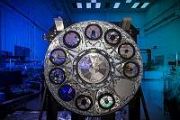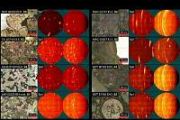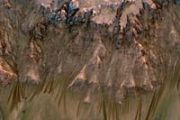
Copernical Team
Most detailed-ever images of galaxies revealed using LOFAR
 The universe is awash with electromagnetic radiation, of which visible light comprises just the tiniest slice. From short-wavelength gamma rays and X-rays, to long-wavelength microwave and radio waves, each part of the light spectrum reveals something unique about the universe.
The LOFAR network captures images at FM radio frequencies that, unlike shorter wavelength sources like visible li
The universe is awash with electromagnetic radiation, of which visible light comprises just the tiniest slice. From short-wavelength gamma rays and X-rays, to long-wavelength microwave and radio waves, each part of the light spectrum reveals something unique about the universe.
The LOFAR network captures images at FM radio frequencies that, unlike shorter wavelength sources like visible li Astronomers find a 'break' in one of the Milky Way's spiral arms
 Scientists have spotted a previously unrecognized feature of our Milky Way galaxy: A contingent of young stars and star-forming gas clouds is sticking out of one of the Milky Way's spiral arms like a splinter poking out from a plank of wood. Stretching some 3,000 light-years, this is the first major structure identified with an orientation so dramatically different than the arm's.
Astronom
Scientists have spotted a previously unrecognized feature of our Milky Way galaxy: A contingent of young stars and star-forming gas clouds is sticking out of one of the Milky Way's spiral arms like a splinter poking out from a plank of wood. Stretching some 3,000 light-years, this is the first major structure identified with an orientation so dramatically different than the arm's.
Astronom Celestial Sleuth corrects historical record on Gegenschein discovery
 The discovery of the gegenschein-a faint nighttime glow that appears as a diffuse brightening at the anti-sun, the point in the sky exactly opposite the sun-has usually been attributed to French Jesuit astronomer Esprit Pezenas in 1730.
Now, Texas State University astronomer, physics professor emeritus and Texas State University System Regents' Professor Donald Olson has applied his distin
The discovery of the gegenschein-a faint nighttime glow that appears as a diffuse brightening at the anti-sun, the point in the sky exactly opposite the sun-has usually been attributed to French Jesuit astronomer Esprit Pezenas in 1730.
Now, Texas State University astronomer, physics professor emeritus and Texas State University System Regents' Professor Donald Olson has applied his distin Saturn makes waves in its own rings
 In the same way that earthquakes cause our planet to rumble, oscillations in the interior of Saturn make the gas giant jiggle around ever so slightly. Those motions, in turn, cause ripples in Saturn's rings.
In a new study accepted in the journal Nature Astronomy, two Caltech astronomers have analyzed those rippling rings to reveal new information about the core of Saturn. For their study,
In the same way that earthquakes cause our planet to rumble, oscillations in the interior of Saturn make the gas giant jiggle around ever so slightly. Those motions, in turn, cause ripples in Saturn's rings.
In a new study accepted in the journal Nature Astronomy, two Caltech astronomers have analyzed those rippling rings to reveal new information about the core of Saturn. For their study, NASA's Ingenuity helicopter completes 12th Mars flight
 NASA's Ingenuity helicopter completed its 12th flight on Mars, officials said early Tuesday, as it scouts out the Martian terrain for the Perseverance land rover.
The 4-pound autonomous aircraft flew over the South Seitah region of the Red Planet, traveling a total of 1,476 feet round trip at a height of nearly 33 feet for 169 seconds, NASA's Jet Propulsion Laboratory said via Twitter.
NASA's Ingenuity helicopter completed its 12th flight on Mars, officials said early Tuesday, as it scouts out the Martian terrain for the Perseverance land rover.
The 4-pound autonomous aircraft flew over the South Seitah region of the Red Planet, traveling a total of 1,476 feet round trip at a height of nearly 33 feet for 169 seconds, NASA's Jet Propulsion Laboratory said via Twitter. NASA benefits from Lunar surface simulant testing
 To safely reach the Moon, a lunar lander must fire its rocket engines to decelerate the spacecraft for a soft touchdown. During this process, the engine exhaust stirs up regolith - the dust and rocks on the lunar surface - creating a host of potential challenges, from destabilizing the lander to damaging instruments and reducing visibility.
To dig into this problem, a team from NASA's Kenn
To safely reach the Moon, a lunar lander must fire its rocket engines to decelerate the spacecraft for a soft touchdown. During this process, the engine exhaust stirs up regolith - the dust and rocks on the lunar surface - creating a host of potential challenges, from destabilizing the lander to damaging instruments and reducing visibility.
To dig into this problem, a team from NASA's Kenn Curiosity Mars Rover explores a changing landscape
 Images of knobbly rocks and rounded hills are delighting scientists as NASA's Curiosity rover climbs Mount Sharp, a 5-mile-tall (8-kilometer-tall) mountain within the 96-mile-wide (154-kilometer-wide) basin of Mars' Gale Crater. The rover's Mast Camera, or Mastcam, highlights those features in a panorama captured on July 3, 2021 (the 3,167th Martian day, or sol, of the mission).
This locat
Images of knobbly rocks and rounded hills are delighting scientists as NASA's Curiosity rover climbs Mount Sharp, a 5-mile-tall (8-kilometer-tall) mountain within the 96-mile-wide (154-kilometer-wide) basin of Mars' Gale Crater. The rover's Mast Camera, or Mastcam, highlights those features in a panorama captured on July 3, 2021 (the 3,167th Martian day, or sol, of the mission).
This locat Europe's Vega rocket blasts off with Airbus observation satellite

A European Vega rocket lifted off Monday night from French Guiana carrying an Earth observation satellite and four miniature "cubesats".
It was the second launch this year of the Vega, a crucial component of European ambitions to compete with rivals such as Elon Musk's SpaceX in the booming commercial aerospace market.
The rocket blasted off from the Guiana Space Centre in Kourou at 10:47 pm (0147 GMT), successfully delivering the satellites in just under two hours.
Its main cargo was a high-resolution satellite, the second of four for a new Earth observation constellation operated by Airbus. The first was put in orbit in April by a Vega rocket.
The Pleiades Neo constellation will offer high-resolution imaging of Earth for military or civilian uses such as disaster response, according to Airbus.
Vega's operator Arianespace is a subsidiary of the ArianeGroup, of which Airbus owns half.
Blue Origin sues NASA over SpaceX Moon contract

Blue Origin, the space company owned by Jeff Bezos, is suing the US government over its decision to award a massive Moon exploration contract to its competitor SpaceX, it said in a statement Monday.
The company has filed a suit with the US Court of Federal Claims "in an attempt to remedy the flaws" in how the contract was awarded, according to the statement.
The human landing system (HLS) contract, worth $2.9 billion, was given to SpaceX, owned by Bezos's billionaire rival Elon Musk, in April.
It was protested by the other bidders, who argued NASA was required to make multiple awards and that the evaluation process was unfair.
"We firmly believe that the issues identified in this procurement and its outcomes must be addressed to restore fairness, create competition, and ensure a safe return to the Moon for America," Blue Origin said.
Since losing the contract, Blue Origin has strongly lobbied to have the decision reversed.
Indian Space Research Organisation fails to place earth observation satellite in orbit
 On Thursday, the Indian Space Research Organisation (ISRO) was scheduled to launch Earth observation satellite EOS-03 on the GSLV launcher. The mission was initially expected to be carried out in March 2020 but was postponed due to the coronavirus pandemic.
The Earth observation satellite EOS-03, launched on Thursday from the Satish Dhawan Space Centre (SDSC) SHAR in Sriharikota, failed to
On Thursday, the Indian Space Research Organisation (ISRO) was scheduled to launch Earth observation satellite EOS-03 on the GSLV launcher. The mission was initially expected to be carried out in March 2020 but was postponed due to the coronavirus pandemic.
The Earth observation satellite EOS-03, launched on Thursday from the Satish Dhawan Space Centre (SDSC) SHAR in Sriharikota, failed to 





























